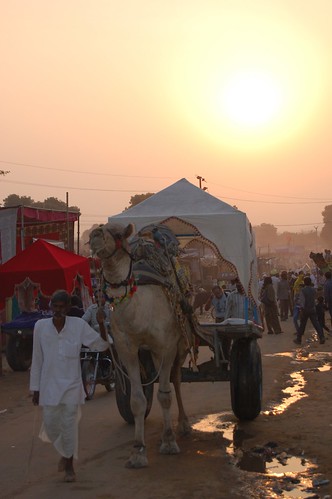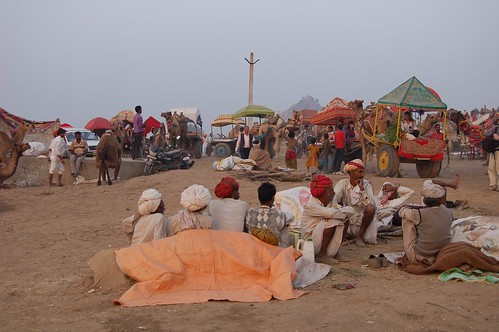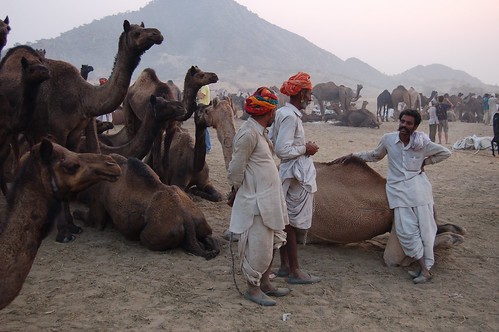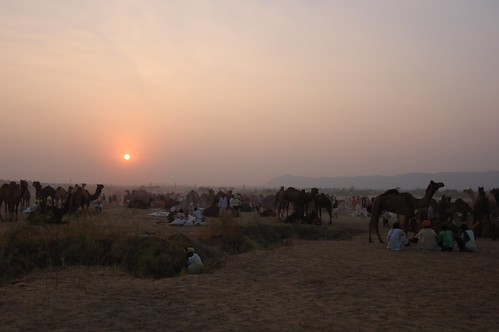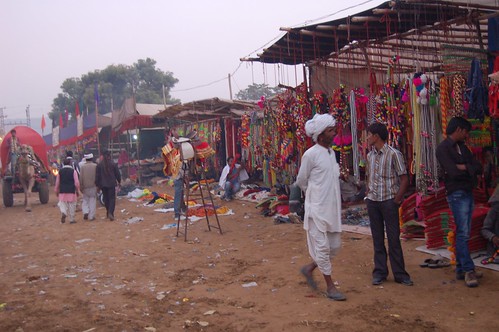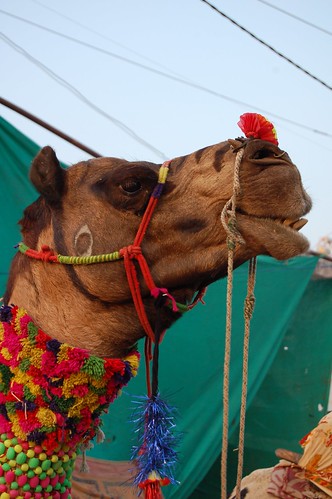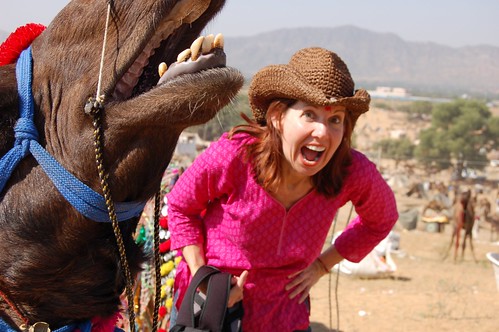Last year around this time, one of my students was absent on Friday and Monday.
“Were you sick?” I asked.
“No…,” she answered. “My mom told me not to tell you that we went to the Pushkar Camel Fair! It was awesome!”
I soon realized many students (and teachers) were “sick” that weekend, so I did a little research on the fair. I discovered the five-day fair takes place every year during the month of Kartika on the lunar Hindu calendar, which falls in October or November. It transforms the sleepy town of Pushkar, in the Indian state of Rajasthan, into a bustling carnival of animal traders, performers, revelers and tourists. Depending on the source, camels at the fair reportedly number from 25,000 to 50,000. That’s a lot of camels. I had to see it. Good thing I didn’t call in “sick” too early – the 2012 Pushkar Camel Fair coincided with our Thanksgiving holiday! I booked the hotel and train tickets far in advance, so you can imagine how excited I was when last weekend finally rolled around.
I’ve done my share of lay-around-the-beach vacations that yield little in the way of blogworthy photos or stories. This was not one of those vacations. This was visual overstimulation like never before. In just 2 ½ days, I took almost 500 pictures. Looking at those snapshots on the computer, I recall the object of my attention at the time, but then I notice about 50,000 other interesting details I missed the first time – in the background, in the foreground, in the crowd, in the clothing, on the faces, on the buildings. It was hard to focus the camera on any one thing in Pushkar, and now it’s hard to focus mentally on any one thing as I recall the experiences from the weekend. The color, the dust, the juxtapositions, the flowers, the spiritual energy, the joy, the peace amidst the chaos. Everyone loves a good beach vacation, but I’m quite sure Pushkar will rank as one of my most treasured trips.
Prepare for an onslaught of photos. I’m struggling to cull.
Home away from home.
My little band of teacher-travelers included Becky, Isaac, Katrina, Nancy and Nancy’s two kids. While Becky and Isaac stayed at a nearby budget hotel, the rest of us booked rooms in two “haveli hotels” owned by a friendly man named Anoop. A “haveli” is a private mansion of historical significance. Anoop lives in the first floor of Dia, a small bed and breakfast, where I stayed in the breezy Anandi Room and enjoyed the company of several cats, two turtles and a happy yellow lab. Nancy’s gang and Katrina stayed at the larger Inn Seventh Heaven, where roots and vines crawl through the balustrades and dangle from the rooftop restaurant. We mostly ate at the Seventh Heaven restaurant, Sixth Sense, patiently waiting for our food to arrive by a rigged metal dumbwaiter, guarding our pancakes from Fat Dog and startling as pigeons took shortcuts through the open windows or landed on the ceiling fans.
Camel cart tour.
Despite waking at 4 a.m. Thanksgiving morning to catch our train and riding for more than six hours on the ironically named Shadtabdi Express, we were all eager to hit the ground running. We followed the crowds to the fairgrounds along a road lined with tempting shops and market stalls, repeating, “We’ll shop in the morning!” Upon arriving at the fairgrounds, we weren’t sure where to start. Fortunately, the camel handlers don’t give you time to think. We all piled into a camel-drawn cart for a ride without any idea where we were going or what to expect. The cart joined a caravan of like-minded tourists and hauled us the short distance to an expanse of desert where camel traders in colorful turbans crouched next to their animals, awaiting shoppers and tolerating the gawkers. The orange hazy sun setting in the dust-darkened sky provided an apt backdrop for this surreal scene.
For camels who like to accessorize.
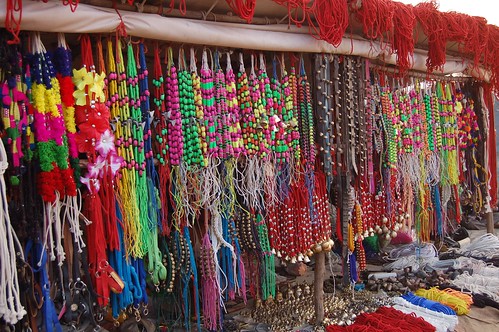
Pushkar is the home of the world’s only temple to Brahma, the Hindu god of creation, and devout Hindus believe a dip in the holy lake will wash away sins of a lifetime. All roads in Pushkar seem to lead to one of the 52 “ghats,” the stairways leading down to the lake. Pilgrims purchase offerings, which they drop into the water with prayers for health, happiness and prosperity. They fill the streets, ladies clad in their most stunning saris with bags balanced on their heads and barefoot men dressed in plain white “lungis,” a long stretch of fabric wrapped and tucked to cover the nether regions, and additional yards of fabric, often neon-bright, twisted into turbans. There was a different vibe here. Everyone seemed to exude a sense that this place was special. Women made eye contact and returned my smile with gentle “namastes,” encouraging their babies to wave. Children laughed and tossed out all their English phrases. “Good morning. Good afternoon. Good evening. Good night,” one boy said proudly. Most men seemed preoccupied by their families or their spiritual journey. We didn’t encounter the swarms of Indians obsessed with taking phone “snaps” with us. We didn’t get the creepy once-over so typical of young men in Delhi. There were stares, as usual, but they were fleeting and moved on quickly to other happy pursuits. I simply couldn’t put down my camera.
Let’s play “spot the foreigner.”
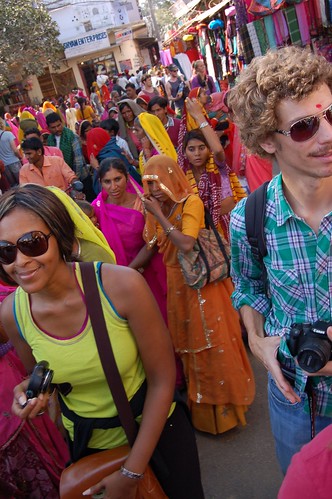
How gorgeous is that little girl?

The colors almost hurt your eyes.

More street shots… Note the motorcycles trying to drive through the crowd, the painted people promoting a music festival, Isaac strangely appearing in several backgrounds, the group of youngsters who ALL asked to shake my hand, little white balls of sugar offered at a shrine, the streetside parking (motorcycle, cow, motorcycle)…
Walking around at night was equally interesting.

Sweet, spicy tea in a tiny clay cup.

More, more, more.
Temple hike
Anoop (the hotel owner) encouraged us to hike up a nearby hill to a small temple overlooking the valley. I do have a weird need to climb things when I’m on vacation, so I convinced Isaac, Becky and Katrina to join me. At the top, we took off our shoes to visit the little temple, where we heard a short Hind-glish version of the temple’s history and purpose from a quirky groundskeeper.

The camel fair features a full program of fascinating events and attractions, including camel dancing, Indian bride competition for foreigners, temple dance, mustache competition, Rajasthani folk music, turban tying competition, and laughter show. I have no idea what most of those were. We only braved the crowds to watch one event: camel dancing, which seemed akin to camel torture. I asked a restaurant owner about another one of the events: Kabaddi.
He explained, “It’s very much like American football. You have a line in the middle with seven players on either side. Then you say ‘kabaddi, kabaddi, kabaddi.'”
…awkward lull while I stare in confusion…
His friend tries to help, “You no say ‘kabaddi,’ man tell you ‘sit down!'”
The two guys looked at each other like it all makes sense and is indeed very much like American football.
I just nodded and said, “Ohhh…Okayyy.”
Here are some scenes from the stadium during the camel dancing. Some of my friends paid to watch from a camel perch, but I just poked around at ground level. I’m kicking myself for not going to that circus!
Looking over the schedule of events and mapping out a tentative plan for our visit, we noted the rent-a-camel option. I wracked my brain, rewinding through 12 years of living overseas and a lifetime of travel … had I ever ridden a camel before? It’s possible I’m wrong, but I do believe Pushkar provided my first-ever camel ride! How is that possible?
We all boarded camels at the fairground and rode out to the same area we visited on our cart ride. My camel handler was about 8 years old and tough as nails. He walked us through the horse market, where the swanky horse owners threw a hissy fit to see a grungy camel in their midst. While the boy was arguing with them, my camel slyly tried to nip a taste of fresh bundled greens clearly intended for the spoiled fancy horses, but he got yanked back before he could sneak a snack. Out in the camel field, the handlers made us dismount so we could shop at their makeshift souvenir tent. That was a bit annoying, but it gave us an opportunity to act like idiots for some silly pictures. I thought it would be funny to put my hat on the camel and strike a pose like, “Yo camel, why’d you take my hat?” However, the camel thought it would be funnier to snap his big yellow teeth at me and strike a pose like, “Yo dummy, I am way too cool for that stupid hat.” After the camel and I had come to an agreement, the handler said, “No touch camel. No hat to camel.” Yes, thank you, the camel already made that perfectly clear.

More camel ride photos.
Sacred lake.
Hoping to spend some quiet time lakeside, we walked down the steps at one of the “ghats” that lead to Pushkar Lake. Immediately we were accosted and handed a metal pan of religious paraphernalia. A man guided me to sit on the steps while he led me through a litany of prayers using a coconut, flower petals, red paste to mark the third-eye on my forehead, rice to symbolize prosperity, sugar, and a string, which he tied around my wrist with a blessing. He told me to repeat after him, so I uttered the names of many Hindu deities (Durga, Ganesha, Shiva, Parabrahma…) along with random phrases like “happy father, happy mother, happy husband, everybody happy, everybody healthy…” Then he told me to hold the coconut and say my own prayers silently before taking my pan down to the water’s edge to dump the contents as an offering. Done and done.

View from a rooftop restaurant.
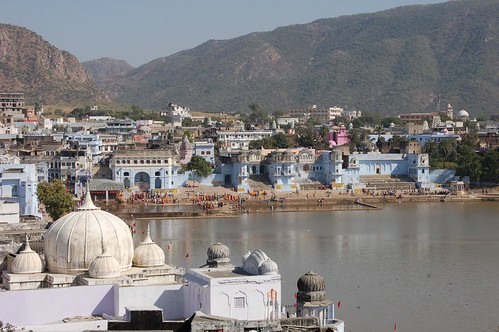
While the rest of our crowd headed home Saturday afternoon, Katrina and I stayed an extra day. After a chat with Anoop, we decided to enjoy a leisurely walk in the countryside. My hotel, Dia, sat at the edge of town. We were all prepared to check out hillside temples and freshwater springs until Anoop warned us about the red monkey. “He’s pathologically psychotic,” he said, explaining that someone at one of the temples used to feed him opium or something. Since that guy skipped town, the red monkey is off his rocker, attacking people without provocation and even climbing through windows to bite people in their own homes. So… change of plans. We still went for a walk, but we mostly stayed in the dry irrigation canal and steered clear of the temples and the springs. We didn’t see the famed red monkey, but on the way back to the hotel, we saw a monkey aggressively jump on the back of a pig, riding it for a bit while the pig squealed and ran in terror. Awesome.

